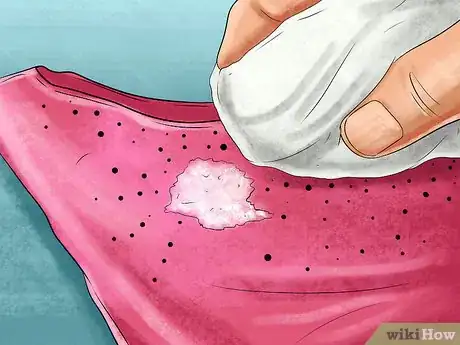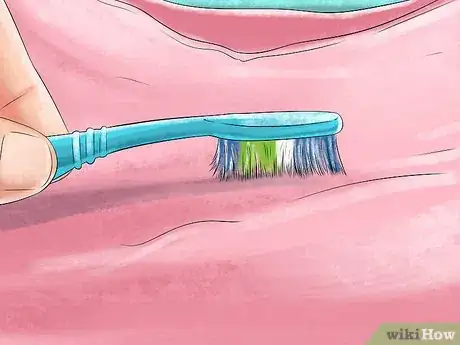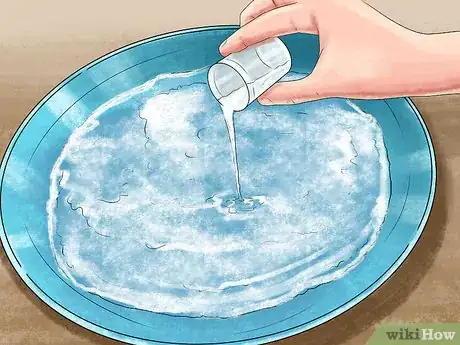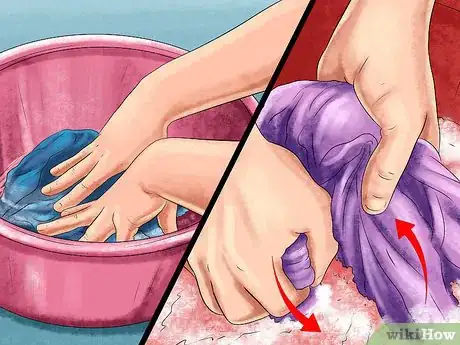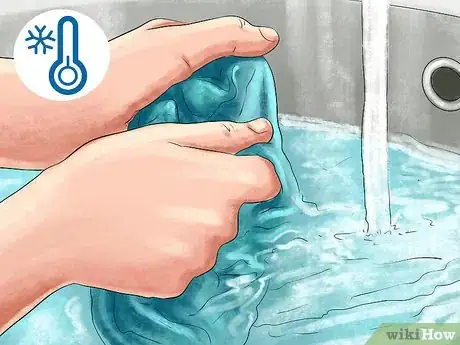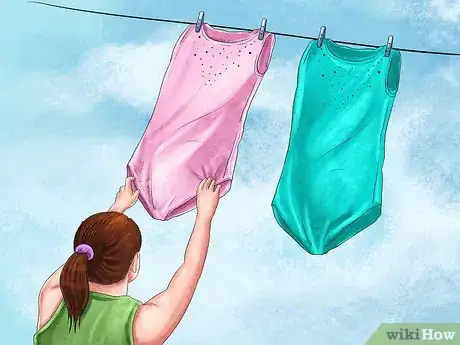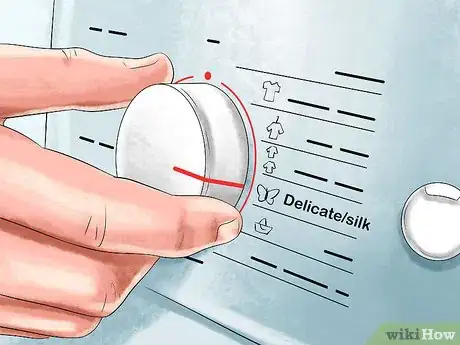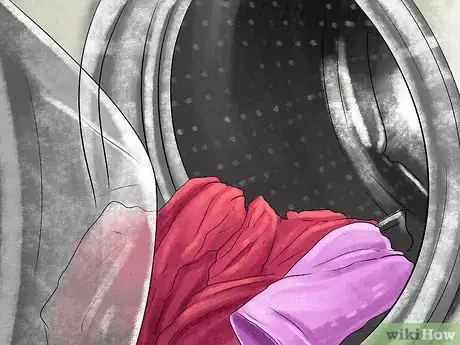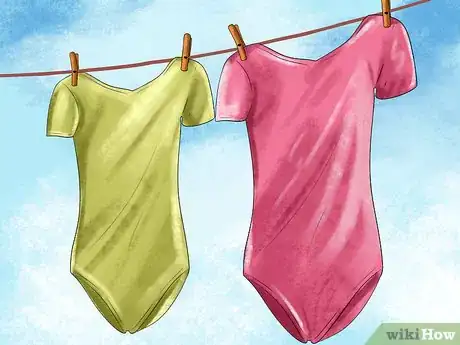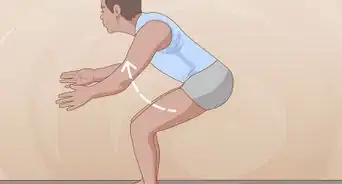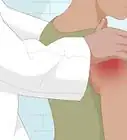This article was co-authored by Ayad Mirjan. Ayad Mirjan is a Dry Cleaner and Laundry Specialist and the Founder of OrangeBag®, a toxin-free, sustainable, Los Angeles-based laundry and dry cleaning delivery service. Ayad has over four years of experience in the industry and he specializes in providing easy laundry and dry-cleaning solutions to professionals, families, and businesses. Ayad received his Bachelor's degree from The University of California, San Diego, and an MBA from Henley Business School. He is also a board member of the Entrepreneur's Organization Accelerator (EOA).
This article has been viewed 70,392 times.
Whether you are a dancer, gymnast, or you simply prefer the look of leotards, taking care of your leotards will keep your budget low and the quality of your threads high. Washing leotards can be tricky, as they should be handled carefully. With delicate treating, hand washing, and machine washing, your leotards will stay stretchy, saturated with color, and in good working condition.
Steps
Spot-Treating Leotards
-
1Choose your stain remover. The source of the stain will play a role in how you get rid of it. A tomato-based stain, for instance, requires a different approach to removal than an ink stain. Removal tools include chalk, baking soda, peroxide, and vinegar, each of them ideally suited to a certain type of stain.[1]
- Vinegar is great for whitening and removing grass stains.
- Oil stains (including face and body oils) are best removed with chalk or salt, as they absorb oil.
- Coffee and other dark stains are best removed with a 1:1 ratio of baking soda and water to make a paste.
- Peroxide is the most effective way to remove bloodstains, though it can have a bleaching effect.
-
2Place a dab of your remover onto the stain. After you have identified which stain remover is appropriate, place the removal method onto the stain, making sure your hands or laundry brush are clean and free of oil and debris.
- Wash your hands before handling your leotards to avoid depositing dirt or your body's oils as you clean.
Advertisement -
3Rub the stain remover in. Use a finger, a soft-bristle toothbrush, or a delicate laundry brush. If the stain is small, you can use your finger to rub the detergent in. If the stain is larger, enlist the help of a soft-bristle toothbrush (hard bristles can snag fabric) or a dedicated laundry brush with soft bristles.[2]
-
4Rinse the stain in cool water. Rinse the stain in cool water--never hot. Hot water can set stains in the fabric. Rinse the stained area with cool water, avoiding getting the rest of the garment wet, as this can cause the color or stain to run onto the rest of the fabric.
- If you are treating a leotard with many different colors, all of them prone to running, you can place your hand underneath the stain to make sure only that portion of the leotard gets wet.
-
5Wash as usual. After pre-treating, launder your leotard as usual, turning it inside out before washing. While all leotards can benefit from hand washing, make sure you at least wash your performance leotards by hand.
- Your practice leotards may hold up well inside of a machine wash.
Washing By Hand
-
1Look at your care tags. The best indicator of how a leotard should be washed is the care tag. While these are usually attached to leotards, some come separately.
- Many care tags will say “Dry clean only.” Although this can be a bother, you should adhere to the instructions on the tag, as this will ensure your leotard performs optimally.
-
2Fill a 2-4 gallon (15.1 L) basin with cool water. Fill a large basin with cool-lukewarm water. You should be able to place your hands in the basin without discomfort.
-
3Place a quarter-sized amount of liquid detergent into the basin. To clean your leotards, place a quarter-sized amount of detergent into the basin, avoiding powders. Powdered detergent may not be able to break down fully in cool water and may snag your fabric, so liquid detergent is a must.
- Gentle detergents such as baby detergent are best for leotards, as the fibers present in leotards are quite delicate and easily damaged.
-
4Stir until the detergent has dissolved. Using your hands or a spoon, stir the detergent in the water until you see bubbles on the surface of the water, and all of the detergent has dissolved. If your hands or the spoon still feel slimy, continue to stir.
- If the slimy feeling persists, you may have used too much detergent. You can dump out ½-⅔ of your mixture, and refill the basin the rest of the way with water.
-
5Place your leotard into the basin inside-out. Lower your leotard into the water, stopping along the way if you notice any of the color fading or bleeding. If the color continues to bleed, make sure it does not stain any other suits by washing each of them separately.
- If you have a multi-colored leotard and see the color running, wash each side of the leotard separately, if possible.
- If the color continues to run and washing each color separately is not possible, you may need to have your leotard dry cleaned.
-
6Gently “agitate” the garment between your palms. Swish the leotard through the water in circular strokes, then agitate it between your palms to apply the detergent. Do not bunch your leotard during this process; instead, place the fabric between your palms and rub your hands together. Keep moving down the fabric until the entire leotard has been washed in this manner.[3]
-
7Rinse in cool water. Once all of your leotard has been covered in soap and water and thoroughly cleaned, remove it from your basin and rinse it in fresh, cool water--again, avoiding hot water. Rinse until the water runs clear of both soap bubbles and color.
- Removing all of the soap from the fabric will help your leotard last longer. Leaving soap behind can result in the breakdown of fabric, and a loss of vibrant color.
-
8Press water from the fabric. Gently press your hands together, but do not wring your leotard. Instead, press the water from the fabric using a towel or your hands, keeping the leotard in its original shape.
- Wringing your leotard can cause it to lose its shape and can damage the elastic and spandex in the fabric. If you are having trouble removing water on your own, you can hang your leotard to drain water over a bathtub or sink.
-
9Hang or lay flat to dry. Using either a line or a hanger, hang or lay your leotard to dry, avoiding the sun and spots directly beneath or beside a heater vent.[4]
- If you are using a hanger, pin the leotard to the hanger to avoid making “dents” in the fabric.
- If you are laying over a drying surface, quickly wipe it down to make sure you do not deposit dirt on your freshly-cleaned leotard.
- If your leotard has multiple colors, it should be laid flat to dry to prevent the colors from running together.
Washing in the Machine
-
1Separate your practice leotards. Because competition and performance leotards are usually adorned with foil, sequins, rhinestones, and other delicate decorations, these are not fit for use in a washing machine. Instead, wash only your basic leotards in a machine.
- If your practice leotards are prone to bleeding, washing one at a time, or washing with similar colors will prevent discoloration.
-
2Place your washer on the “delicate” cycle. If you use your washer, you must use the delicate cycle, as the delicate cycle will not agitate the wash as drastically, and will not pull or yank on the delicate fibers of your leotard. “Permanent Press,” while a more delicate cycle, is still too harsh a setting.
- Use the shortest delicate cycle possible. The longer your leotards are in the machine, the higher the risk of damage is, so use the shortest cycle possible for your machine, including a single rinse.
-
3Run cold water. Because you can use your hands to gauge the water's temperature, hand-washing is fine in lukewarm water. A washer's “warm” cycle, on the other hand, might be a bit too warm for delicate fabrics.[5]
- Note that some powdered detergents do not dissolve well in cold water and some liquid soaps do not disperse. Check your detergent to make sure it is formulated for cold water.
-
4Place your leotards into the washbasin. Place your leotards into the basin, gently layering around the agitation spindle, if your washer has one. Do not overload the washer's chamber. Instead, wash only 3-5 leotards at one time.
- Overloading your washer can cause your leotard to get caught on the machine's spindle, or caught in the door.
- Overloading can also make the rinse cycle less effective, leaving behind dirt and detergent.
-
5Hang or lay flat to dry. Do not place your leotard in the dryer; although a washer can be placed on a delicate mode to protect your leotard, the heat and tumbling of a dryer can damage your leotard.
- Excess heat will damage the elastic properties of the fabric, dramatically increase wear on metallic or other effects, and may even shrink the leotard.
- If you must use a dryer, use a no-heat setting and make sure the leotard is inside-out.
Community Q&A
-
QuestionHow do I wash tights?
 Community AnswerPut them in a small mesh laundry bag and throw them in with the rest of your load for a regular wash cycle.
Community AnswerPut them in a small mesh laundry bag and throw them in with the rest of your load for a regular wash cycle. -
QuestionHow do I get the smell of sweat out of a competition leotard?
 Community AnswerUse baby powder and warm water. Rub the baby powder into the desired area, then wipe it away, then rub gently with a warm, wet wash cloth.
Community AnswerUse baby powder and warm water. Rub the baby powder into the desired area, then wipe it away, then rub gently with a warm, wet wash cloth.
Warnings
- Do not wring a wet leotard.⧼thumbs_response⧽
- Do not bleach your leotards, as it can damage the elastic.⧼thumbs_response⧽
- Leotards with both dark and light colors should be hung with the light side higher than the dark. This way, if the color bleeds, it will not stain the lighter color.⧼thumbs_response⧽
- Do not iron a leotard. Leotard fabric stretches to fit the wearer, so wrinkles will disappear when the leotard is worn.⧼thumbs_response⧽
References
- ↑ http://www.artofmanliness.com/2013/03/28/how-to-remove-stains/
- ↑ http://www.cleaninginstitute.org/clean_living/stain_removal_chart.aspx
- ↑ http://www.elevedancewear.com/pages/Policies.html
- ↑ http://integrityop.com/gymnasts-leotards-last-longer/
- ↑ http://www.dancemania.biz/blog/how-to-look-after-your-gymnastics-leotard/

